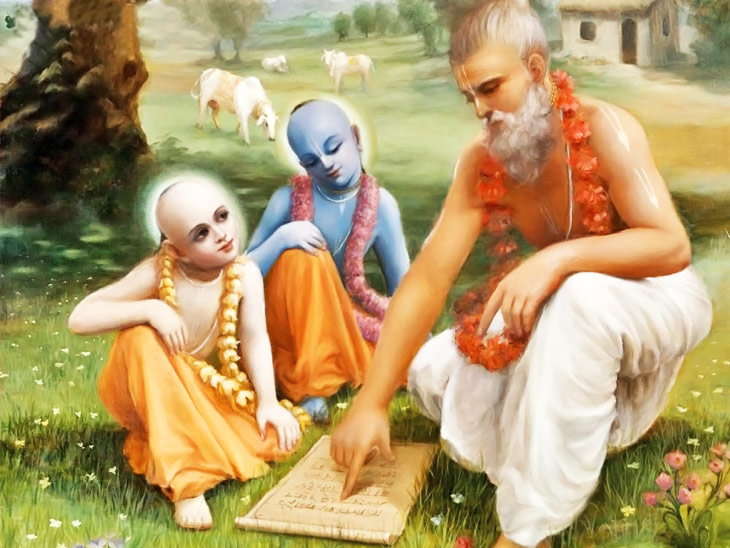A sweet fantasy tucked inside the heart every Indian is that one day India will emerge as “Vishwa Guru“.We always see to our past to get inspiration and overcome our failures and frustrations. With such huge and magnificent reservoir of ancient wisdom, this is not something that is unachievable. Unless we go to our roots, get the strength from our ancient reservoir, we cannot achieve the place of Vishwa Guru. But, unfortunately, our present day education does not resonate with our ancient wisdom. Present day education is just not equipped for this. We can simplify this by saying that there is no place for ‘Samskar’ in it. What else can we expect from the education system that was developed to make millions of babus and pseudo intellectuals to serve their empirical bosses?
After independence we got a chance to overhaul our education system that unfortunately we lost. We can blame policy makers of that time for bad education planning. But it will be giving unnecessary credit to our first Prime Minister Mr Nehru for bad planning. Actually, it was not bad planning, it was lack of planning. He never made any efforts in this direction. We can’t blame someone for something doing badly that he never did. There was total lack of a sound and comprehensive education policy that was made exclusively for India. Smitten by the charm of western world, Nehru continued the traditions laid by his colonial predecessors. Centres of education established just after independence were poor caricatures of their grand western counterparts. Their academic structure, curriculum, and inspiration of knowledge were copied as it is. I cannot forget an incidence when I was planning my higher education, a very senior academician from a very reputed university graced me with piece of knowledge and said –“See, these two are the best Universities in India, one follows the Oxfordian pattern and other one is based on pattern of Cambridge.” Last month I received a promotional message that said that our play school is best because we follow American curriculum only. This thought process of high and mighty ensured that our education system was totally out of sync with BHARAT or real India. The trend that was established on higher level was trickled down to secondary and primary education also. There was a whole generation that was ready to ridicule and reject anything that was remotely related to “Bharat”. Unfortunately no country can thrive on borrowed education and value system.
Definitely, we need huge change in our education system at every level. When I say “change”, I don’t mean by changes in infrastructure, teachers training, curriculum and other administrative changes. Any efficient officer backed by political will can do this. But these changes will not awaken the soul of our education. To achieve this, we need to change the equation between education and educator, educator and learner, learner and education.
To reverse the trend, we need to look back in past. I don’t say that time can be reversed and we can replicate what was there in past, but, we can definitely take a leaf out of that book and do the best. Our ancient education system was necessarily value based. In GURUKUL system, students used to go to Guru’s place, live there and study. There was no fixed fee. Financially, Gurukuls were dependent on state patronage/grants or donations by public. It could be land or big amount given by a rich merchant or vegetables, milk provided by a poor farmer. For their entire student life their teachers were their guardians, Gurukul their home and fellow students their family. For a Guru, all students residing in his Gurukul were equal regardless of the position of their family. Whatever Guru had was passed on to student without expecting any immediate gain.
Coming back to present day Indian education, it is not possible to replicate Gurukuls, but we can adapt its features. At this time, education has turned into a commodity. Main reason for this is mindless privatisation of education. Due to government policies people who have money are owners of educational institutes regardless of their academic credentials. They are running institutes like any other business, with best infra structure, exorbitant fee structure and no value system. People who can afford them, send their children there. On the other hand there are schools run by government that have almost no infrastructure and other facilities. For private institution run as a business model, students are not someone who has come to them to receive education but a customer. To rectify this, we need a robust state own network of educational institute. This will develop a feeling of equality between students. A person nurtured in such atmosphere will always have the feeling of empathy for their fellow countrymen. They will make wonderful administrators and leaders.
There is one more prominent attribute that we must try to take from our traditional school system. Traditionally, in India, teacher is not someone whose sole responsibility is to impart market driven information to his pupil. Traditionally, the teacher is a guardian and mentor for his students throughout his student life and responsible for character building of his Shishya. A student was always called the Shishya of same Guru although he was taught by several other Gurus also. Thus a very special life long bond was created between them that kept Shishya grounded forever.
To give our children best of education we need a thoughtfully created amalgamation of tradition and modernity. It may take years, it may take decades, but this is only option that we have.
Author- Dr. Chitra Awasthi
Dr. Chitra is a sociologist by training, and her work has focused on the interaction of Indic texts and spiritual traditions with modernity and contemporary Indian society. Her engagement is not exclusively intellectual, and her organisation, Rit Foundation, is dedicated to skill development and educational initiatives.She is currently working on a book on the Bhagavadgita.
